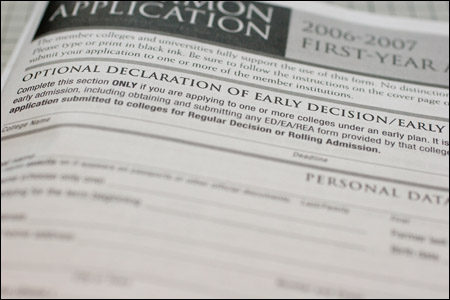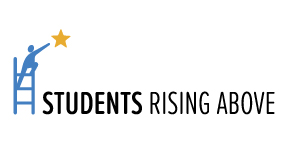It’s No Wonder….
- Posted by Students Rising Above
- Categories Blog
- Date November 21, 2013

By Lynne Martin, Executive Director
It’s college application season for our new class of 100 students. The dream of going to college now is a realistic possibility, and the hard work begins.
If you’re the first in your family to go to college the application process can seem overwhelming.
There may be no one at home to help you. Or, if you’re
It’s college application season for our new class of 100 students. The dream of going to college now is a realistic possibility, and the hard work begins.
If you’re the first in your family to go to college the application process can seem overwhelming.
There may be no one at home to help you. Or, if you’re
attending an inner city high school, the counselor to student ratio can be 1 to 500. If you happened to grow up in poverty, or have been homeless, or abandoned, the process may be even more exasperating. Do you write about that experience in your personal essay?
Even if you do overcome these challenges, then there’s the question of money – how do you pay for college? Just one look at the financial aid form known as the FASFA, and it’s no wonder many college-eligible, low-income, first generation students don’t apply.
Take heart: You and your family are not alone. You are not the first ones to encounter this challenge. With persistence, planning, and realistic expectations, a student who has faced hardship can minimize the angst of applying to college and start down the road toward defining your future.
Defining the Goal
The first priority for all students – no matter what their background – is properly defining the goal: Graduating with a four-year degree with as little student loan debt as possible.
Next is identifying the “right” school at the right price that matches your aptitude and interests. As much as anything, attending college is a big economic decision and you have to make smart decisions right from the start.
Nationally, 57 % of students graduate from public universities and colleges with an average of $27,000 in student loan debt. The numbers increase if you’re graduating from a private college; 67% of students graduate with an average of $29,000 in student loan debt. We believe that’s too much. Digging out from that amount of debt usually postpones prosperity and discourages students from undertaking the journey.
Three College Application Strategies
At Students Rising Above, we encourage our students to apply to a mix of schools: CSU’s, UC’s, and private colleges. Our objective is for each student to receive multiple admission offers with the greatest financial aid possible. For each college system, there is a different approach:
California State University (CSU) campuses accept students with low to mid-range GPAs , test scores, and require no personal essay. They give priority to students who live in their geographic region. Students interested in a CSU outside of their locale will need higher grades and test scores. This summer, the California State University launched a system-wide concurrent enrollment initiative to provide full-time students enrolled at any campus with access to fully online courses offered at other CSU campuses.
University of California (UC) System requires GPAs of 3.4 and higher, top test scores, and a personal essay. Highly competitive, the greatest opportunities for enrollment occur with the less impacted campuses such as UC Merced and UC Riverside.
Private colleges are also a very important option, and should not be considered out of reach. We encourage our students to apply to 4-5 private colleges. There is a wide range of options geared to accommodate a variety of academic needs. For our students with high GPA’s, we encourage them to apply to the elite colleges. Too often, our students mistakenly believe these universities would not be interested in them. In fact, many want low-income students and will provide significant financial aid.
Good News
The good news is that more students are graduating from college and the value of a college education has never been greater. To assist students in the college application and selection process, the Department of Education is launching a new rating system of higher education institutions that will help students decide where they should go to school, and as a way to distribute over $130 billion in federal financial aid each year.
Working together, we can break the cycle of poverty through education for the benefit of all.
Even if you do overcome these challenges, then there’s the question of money – how do you pay for college? Just one look at the financial aid form known as the FASFA, and it’s no wonder many college-eligible, low-income, first generation students don’t apply.
Take heart: You and your family are not alone. You are not the first ones to encounter this challenge. With persistence, planning, and realistic expectations, a student who has faced hardship can minimize the angst of applying to college and start down the road toward defining your future.
Defining the Goal
The first priority for all students – no matter what their background – is properly defining the goal: Graduating with a four-year degree with as little student loan debt as possible.
Next is identifying the “right” school at the right price that matches your aptitude and interests. As much as anything, attending college is a big economic decision and you have to make smart decisions right from the start.
Nationally, 57 % of students graduate from public universities and colleges with an average of $27,000 in student loan debt. The numbers increase if you’re graduating from a private college; 67% of students graduate with an average of $29,000 in student loan debt. We believe that’s too much. Digging out from that amount of debt usually postpones prosperity and discourages students from undertaking the journey.
Three College Application Strategies
At Students Rising Above, we encourage our students to apply to a mix of schools: CSU’s, UC’s, and private colleges. Our objective is for each student to receive multiple admission offers with the greatest financial aid possible. For each college system, there is a different approach:
California State University (CSU) campuses accept students with low to mid-range GPAs , test scores, and require no personal essay. They give priority to students who live in their geographic region. Students interested in a CSU outside of their locale will need higher grades and test scores. This summer, the California State University launched a system-wide concurrent enrollment initiative to provide full-time students enrolled at any campus with access to fully online courses offered at other CSU campuses.
University of California (UC) System requires GPAs of 3.4 and higher, top test scores, and a personal essay. Highly competitive, the greatest opportunities for enrollment occur with the less impacted campuses such as UC Merced and UC Riverside.
Private colleges are also a very important option, and should not be considered out of reach. We encourage our students to apply to 4-5 private colleges. There is a wide range of options geared to accommodate a variety of academic needs. For our students with high GPA’s, we encourage them to apply to the elite colleges. Too often, our students mistakenly believe these universities would not be interested in them. In fact, many want low-income students and will provide significant financial aid.
Good News
The good news is that more students are graduating from college and the value of a college education has never been greater. To assist students in the college application and selection process, the Department of Education is launching a new rating system of higher education institutions that will help students decide where they should go to school, and as a way to distribute over $130 billion in federal financial aid each year.
Working together, we can break the cycle of poverty through education for the benefit of all.
You may also like
-
Written By Wendy Tokuda, Award-Winning Journalist and Founder of SRA One person can make all the difference in the world. For three Students Rising Above students, that person was Jim Wallace. He was a humble, gentle man, who never wanted …
-
San Francisco, CA – Students Rising Above (SRA) is proud to announce the appointment of Angela Bugayong as its Interim Chief Executive Officer (CEO). With more than fifteen years of experience in nonprofit management and the field of college attainment, …
-
Greetings, When I joined the team of Students Rising Above at the end of 2019, I knew this was a very special community. Not only had SRA’s comprehensive programs and services been built by dedicated staff and volunteers over many …
